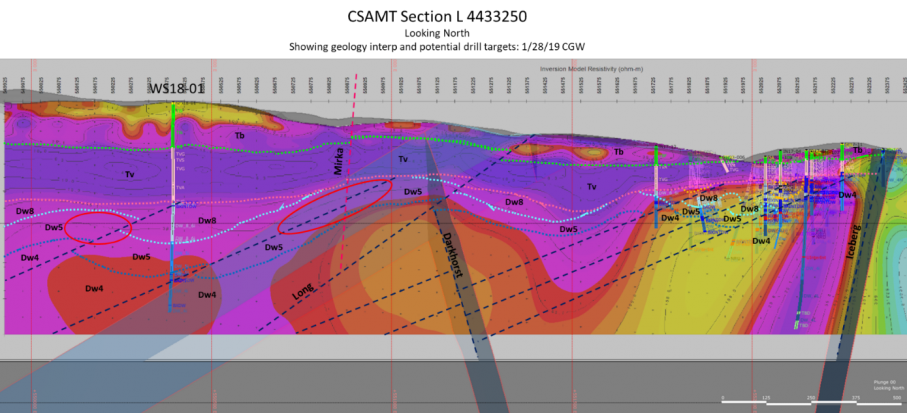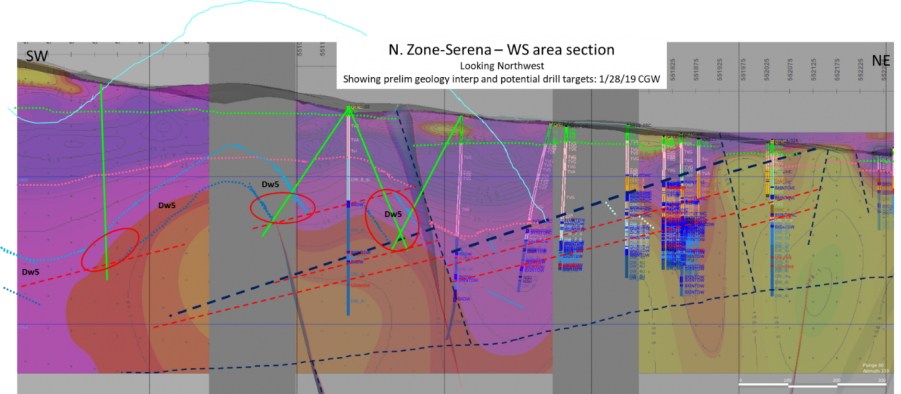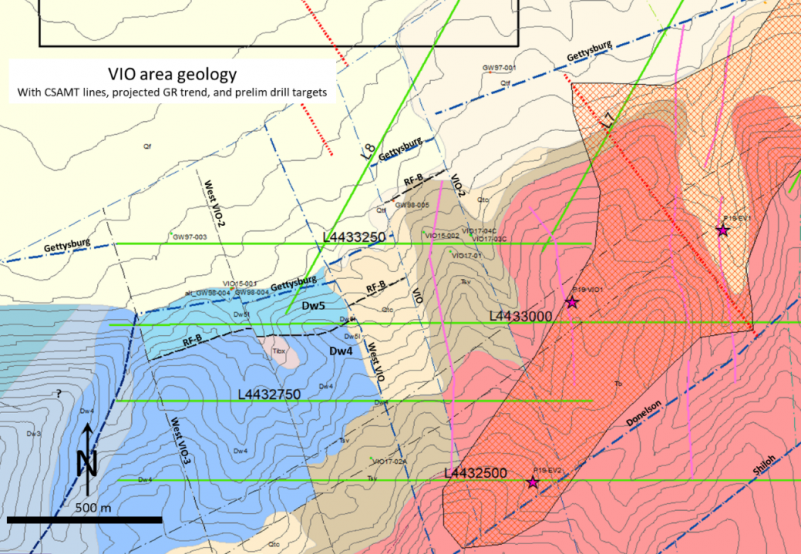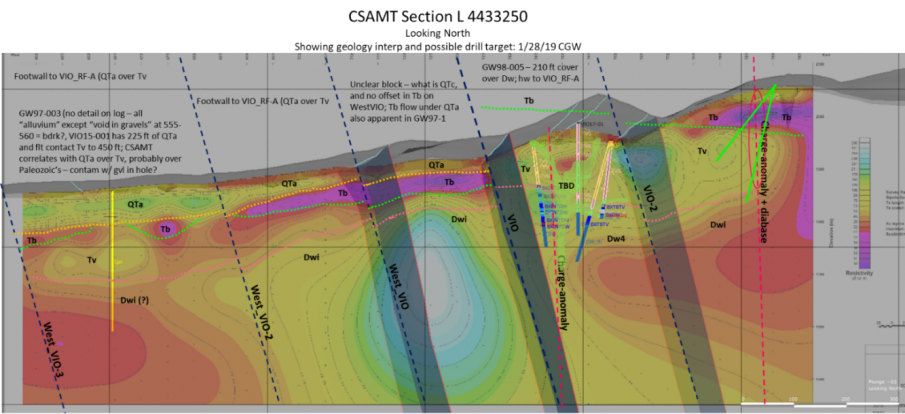Red Hill Property – Progress Update
Charles Weakly (Feb 2019)
Progress Summary:
Summary of major points:
- Advances in drill targeting show potential for moderate scale folding associated with reverse faults between the Rift and Serena areas, within the Rift area, and the East VIO area. Some of these features would also project to the north into the West Avocado target area.
- AV18-01C intercepted around 500 feet of Wenban unit 5 (likely Au-controlling fault occurred above the zone mostly within the Dw8-6). This represents significant stacking of the host section, so possible follow-up targeting between here and the interpreted Iceberg fault to the west should remain under consideration.
- A drill target concept on the Idaho block occurs at the intersection of the footwall of a major NNW trending normal fault and low angle west dipping thrusts within the Wenban unit 5. Other than general surface soil Au anomalies, this NNW fault lacks evidence of being a significant mineralizing conduit. This concept is worth further investigation, especially in light of the over 900 feet of intercepted Dw5 in drill hole RHI11-001 (farther south on the Idaho block).
- Range front-ENE faults in the VIO area show offset across the NNW trending VIO faults. This is different from the apparent significant offset of the NNW trending Iceberg and related faults by Range Front/Long-type faults at the CMZ and East to Central Avocado area. It is unclear if there are significant targeting impacts to this difference in timing of offsets. The offsets of ENE faults by NNW faults is more typical at Goldrush-Fourmile area.
- The different generations of CSAMT programs have variations in inversion parameters and color scales. Geological units at surface appear to have a significant impact on the response of other units at depth. Each generation should be interpreted with these variations in mind, and grounded in surface and existing drill hole geology.
Drill Targeting Serena to Rift to VIO areas
CSAMT section L 4433250 is closest to drill hole WS18-01. The figure below illustrates the likely anticline as well as uplift across the Darkhorst fault between the North Zone/Serena area and the Rift anticline area. Assuming a west dipping fault is responsible for the intercept in the Dw4 of WS18-01, this fault would intercept a significant zone within the Dw5 to the east. This target could be drilled from the existing rift road. The interpreted fold just to the west of WS18-01 is part of a broader upwarp shown in the other CSAMT sections, the west dipping reverse fault is based on a short intercept of Dhc between the Tv and Dw8-6 in WS18-01. This specific target could be drilled with an angle hole off the WS18-01 pad. The higher priority would be to step to the south and intercept this target in proximity to the Long fault.

The screen shot below is a section across the North Zone-Serena area and Western Slope 2017 holes, and shows portions of 3 CSAMT sections. It takes the idea of an anticline between the North Zone and Rift to a more extreme level – resulting in possible targets that could be drilled from the WS17 pads, and the existing Rift road as in the section above.

A review of the VIO holes, logs of GW holes, surface mapping and CSAMT data shows offset of at least two prominent range front ENE-trending faults across the NNW trending VIO faults.

CSAMT cross section L4433250 is the closest to existing VIO drilling and shows the Tv unit as relatively resistive, possibly due to near surface strong silicification, and/or general silicification throughout the unit (potential positive for epithermal drill targets). Discontinuous basalt flows are interpreted under surface gravels of the pediment, the basalts thicken dramatically in the pediment to the east – GW97-001 has over 900 feet of basalt logged under relatively shallow gravels. GW97-003 was logged as all gravels, but the CSAMT suggests Tv and possibly Dw bedrock possibly obscured by very poor drilling conditions and abundant contamination from gravels

CSAMT section L4433000 shows links between the North Zone, Rift and VIO areas. The Dw4/Dw4 contact appears to be relatively deep between the Rift and Donelson fault. The surface mapping and VIO drilling suggests the Dw5 has limited surface exposure near the range front and is mostly eroded at the cluster of VIO drilling. Extensive exposures of Dw4 to the west of the West VIO fault suggests stacking of the section. An assumed Sadler/Blasdale pair of reverse fault zones as at Goldrush-Fourmile could provide stacking/folding to accommodate the observed and interpreted geology. The moderate east dipping somewhat resistive block that delineates the East VIO area could represent an additional fault/fold complication, or a strong silicified zone in the carbonates/and or Tv unit. The section below illustrates some preliminary target concepts within 300 to 600 meters of the surface.
Idaho Block
The boundary between lower Horse Canyon units and prior interpreted upper Horse Canyon units on the Idaho block is a N-S to NNW trending, steep east dipping normal fault zone with at least two major strands. Rock units to the east of these faults are Ordovician Vininni Formation. The overall fault zone appears to have in excess of 1600 feet of normal offset. Gold in soils loosely correlate with this fault zone and it’s hanging wall area. Potential drill targets at the intersection of the footwall of this fault zone with Dw5 and associated low angle west dipping faults have yet to be tested (expected depths between 500-600m). The first, or western strand has approximately 250 feet of normal offset, the second, or eastern fault strand appears to have in excess of 1600 feet of normal offset. This fault zone is marked by a strong horizontal gradient change in the gravity and significant steep break in more resistive to less resistive response in the CSAMT. Of interest, RHI11-001 located just to the south of Dw8-6 outcrops on the map below intercepted over 900 feet of Dw5 - significant stacking of the Dw5 similar to surface exposures to the NW.
The foregoing contains forward-looking statements, which relate to future events or future performance (including future exploration plans and potential drill targets for the Red Hill property) and reflect management's current expectations and assumptions based on information currently available to NuLegacy. These forward-looking statements are made as of the date hereof, are neither promises nor guarantees and are subject to numerous risks and uncertainties that may cause future results to differ materially from those expected as more particularly described in NuLegacy’s continuous disclosure documents on SEDAR at www.sedar.com. Readers are cautioned not to place undue reliance on forward-looking statements. The proximity and similarity of the geology, geochemistry and/or mineralization of other deposits in the Cortez gold trend of Nevada including Cortez Horse Canyon and Goldrush is not necessarily indicative of the geology, geochemistry and/or mineralization in NuLegacy’s Red Hill property. The scientific and technical information in this progress update has been approved by Derick Unger, CPG 11927, NuLegacy’s Chief Geologist and a qualified person as defined in National Instrument 43-101.
